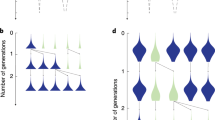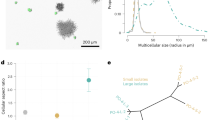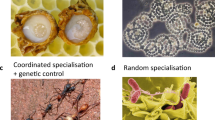Abstract
The evolution of multicellularity has given rise to a remarkable diversity of multicellular life cycles and life histories. Whereas some multicellular organisms are long-lived, grow through cell division, and repeatedly release single-celled propagules (for example, animals), others are short-lived, form by aggregation, and propagate only once, by generating large numbers of solitary cells (for example, cellular slime moulds). There are no systematic studies that explore how diverse multicellular life cycles can come about. Here, we focus on the origin of multicellularity and develop a mechanistic model to examine the primitive life cycles that emerge from a unicellular ancestor when an ancestral gene is co-opted for cell adhesion. Diverse life cycles readily emerge, depending on ecological conditions, group-forming mechanism, and ancestral constraints. Among these life cycles, we recapitulate both extremes of long-lived groups that propagate continuously and short-lived groups that propagate only once, with the latter type of life cycle being particularly favoured when groups can form by aggregation. Our results show how diverse life cycles and life histories can easily emerge at the origin of multicellularity, shaped by ancestral constraints and ecological conditions. Beyond multicellularity, this finding has similar implications for other major transitions, such as the evolution of sociality.
This is a preview of subscription content, access via your institution
Access options
Access Nature and 54 other Nature Portfolio journals
Get Nature+, our best-value online-access subscription
$29.99 / 30 days
cancel any time
Subscribe to this journal
Receive 12 digital issues and online access to articles
$119.00 per year
only $9.92 per issue
Buy this article
- Purchase on Springer Link
- Instant access to full article PDF
Prices may be subject to local taxes which are calculated during checkout





Similar content being viewed by others
Data availability
The study is theoretical; no new empirical data were generated.
Code availability
The simulation code supporting this work is available for download from https://doi.org/10.5281/zenodo.2845406. Pseudocode is available in the Supplementary Methods.
References
Buss, L. W. The Evolution of Individuality (Princeton Univ. Press, 1987).
van Gestel, J. & Tarnita, C. E. On the origin of biological construction, with a focus on multicellularity. Proc. Natl Acad. Sci. USA 114, 11018–11026 (2017).
Maynard Smith, J. & Szathmary, E. The Major Transitions in Evolution (Oxford Univ. Press, 1997).
West, S. A., Fisher, R. M., Gardner, A. & Kiers, E. T. Major evolutionary transitions in individuality. Proc. Natl Acad. Sci. USA 112, 10112–10119 (2015).
Szathmáry, E. Toward major evolutionary transitions theory 2.0. Proc. Natl Acad. Sci. USA 112, 10104–10111 (2015).
Grosberg, R. K. & Strathmann, R. R. The evolution of multicellularity: a minor major transition? Annu. Rev. Ecol. Evol. Syst. 38, 621–654 (2007).
De Monte, S. & Rainey, P. B. Nascent multicellular life and the emergence of individuality. J. Biosci. 39, 237–248 (2014).
Rainey, P. B. & De Monte, S. Resolving conflicts during the evolutionary transition to multicellular life. Annu. Rev. Ecol. Evol. Syst. 45, 599–620 (2014).
Bonner, J. T. The origins of multicellularity. Integr. Biol. 1, 27–36 (1998).
Bonner, J. T. Size and Cycle: An Essay on the Structure of Biology (Princeton Univ. Press, 1965).
Claessen, D., Rozen, D. E., Kuipers, O. P., Søgaard-Andersen, L. & van Wezel, G. P. Bacterial solutions to multicellularity: a tale of biofilms, filaments and fruiting bodies. Nat. Rev. Microbiol. 12, 115–124 (2014).
Coelho, S. M. et al. Complex life cycles of multicellular eukaryotes: new approaches based on the use of model organisms. Gene 406, 152–170 (2007).
Herron, M. D., Rashidi, A., Shelton, D. E. & Driscoll, W. W. Cellular differentiation and individuality in the ‘minor’ multicellular taxa. Biol. Rev. 88, 844–861 (2013).
Lyons, N. A. & Kolter, R. On the evolution of bacterial multicellularity. Curr. Opin. Microbiol. 24, 21–28 (2015).
Griesemer, J. Reproduction in complex life cycles: toward a developmental reaction norms perspective. Philos. Sci. 83, 803–815 (2016).
Libby, E. & Rainey, P. B. A conceptual framework for the evolutionary origins of multicellularity. Phys. Biol. 10, 035001 (2013).
Nanjundiah, V., Kirk, D. & Ruiz-Trillo, I. in Cells in Evolutionary Biology (eds. Hall, B. K. & Moody, S. A.) Ch. 4 (CRC Press, 2018).
Bonner, J. T. Life Cycles: Reflections of an Evolutionary Biologist (Princeton Univ. Press, 1993).
Tarnita, C. E., Taubes, C. H. & Nowak, M. A. Evolutionary construction by staying together and coming together. J. Theor. Biol. 320, 10–22 (2013).
Bonner, J. T. Cells and Societies (Princeton Univ. Press, 1955).
Pichugin, Y., Peña, J., Rainey, P. B. & Traulsen, A. Fragmentation modes and the evolution of life cycles. PLoS Comp. Biol. 13, e1005860 (2017).
Roze, D. & Michod, R. E. Mutation, multilevel selection, and the evolution of propagule size during the origin of multicellularity. Am. Nat. 158, 638–654 (2001).
Grosberg, R. K. & Strathmann, R. R. One cell, two cell, red cell, blue cell: the persistence of a unicellular stage in multicellular life histories. Trends Ecol. Evol. 13, 112–116 (1998).
King, N. The unicellular ancestry of animal development. Dev. Cell 7, 313–325 (2004).
Sebé-Pedrós, A., Degnan, B. M. & Ruiz-Trillo, I. The origin of metazoa: a unicellular perspective. Nat. Rev. Genet. 18, 498–512 (2017).
Brunet, T. & King, N. The origin of animal multicellularity and cell differentiation. Dev. Cell 43, 124–140 (2017).
Suga, H. & Ruiz-Trillo, I. Development of ichthyosporeans sheds light on the origin of metazoan multicellularity. Dev. Biol. 377, 284–292 (2013).
Sebé-Pedrós, A. et al. Regulated aggregative multicellularity in a close unicellular relative of metazoa. eLife 2, e01287 (2013).
Sogabe, S. et al. Pluripotency and the origin of animal multicellularity. Nature https://doi.org/10.1038/s41586-019-1290-4 (2019).
Hammerschmidt, K., Rose, C. J., Kerr, B. & Rainey, P. B. Life cycles, fitness decoupling and the evolution of multicellularity. Nature 515, 75–79 (2014).
Ratcliff, W. C., Denison, R. F., Borrello, M. & Travisano, M. Experimental evolution of multicellularity. Proc. Natl Acad. Sci. USA 109, 1595–1600 (2012).
Ratcliff, W. C. et al. Experimental evolution of an alternating uni- and multicellular life cycle in Chlamydomonas reinhardtii. Nat. Commun. 4, 2742 (2013).
Koschwanez, J. H., Foster, K. R. & Murray, A. W. Sucrose utilization in budding yeast as a model for the origin of undifferentiated multicellularity. PLoS Biol. 9, e1001122 (2011).
Herron, M. D. et al. De novo origins of multicellularity in response to predation. Sci. Rep. 9, 2328 (2019).
Hanschen, E. R. et al. The Gonium pectorale genome demonstrates co-option of cell cycle regulation during the evolution of multicellularity. Nat. Commun. 7, 11370 (2016).
King, N., Hittinger, C. T. & Carroll, S. B. Evolution of key cell signaling and adhesion protein families predates animal origins. Science 301, 361–363 (2003).
Rokas, A. The molecular origins of multicellular transitions. Curr. Opin. Genet. Dev. 18, 472–478 (2008).
Sebé-Pedrós, A. et al. The dynamic regulatory genome of Capsaspora and the origin of animal multicellularity. Cell 165, 1224–1237 (2016).
Rossetti, V., Filippini, M., Svercel, M., Barbour, A. D. & Bagheri, H. C. Emergent multicellular life cycles in filamentous bacteria owing to density-dependent population dynamics. J. R. Soc. Interface 8, 1772–1784 (2011).
Furusawa, C. & Kaneko, K. Origin of multicellular organisms as an inevitable consequence of dynamical systems. Anat. Rec. 268, 327–342 (2002).
van Gestel, J. & Nowak, M. A. Phenotypic heterogeneity and the evolution of bacterial life cycles. PLoS Comp. Biol. 12, e1004764 (2016).
Pichugin, Y. & Traulsen, A. Reproduction costs can drive the evolution of groups. Preprint at bioRxiv https://doi.org/10.1101/325670 (2018).
Rashidi, A., Shelton, D. E. & Michod, R. E. A Darwinian approach to the origin of life cycles with group properties. Theor. Popul. Biol. 102, 76–84 (2015).
Gao, Y., Traulsen, A. & Pichugin, Y. Interacting cells driving the evolution of multicellular life cycles. PLoS Comp. Biol. 15, e1006987 (2019).
Ratcliff, W. C., Herron, M., Conlin, P. L. & Libby, E. Nascent life cycles and the emergence of higher-level individuality. Philos. Trans. R. Soc. B 372, 20160420 (2017).
Willensdorfer, M. On the evolution of differentiated multicellularity. Evolution 63, 306–323 (2009).
Gavrilets, S. Rapid transition towards the division of labor via evolution of developmental plasticity. PLoS Comp. Biol. 6, e1000805 (2010).
Ispolatov, I., Ackermann, M. & Doebeli, M. Division of labour and the evolution of multicellularity. Proc. R. Soc. B. 279, 1768–1776 (2012).
Garcia, T., Brunnet, L. G. & De Monte, S. Differential adhesion between moving particles as a mechanism for the evolution of social groups. PLoS Comp. Biol. 10, e1003482 (2014).
Garcia, T., Doulcier, G. & De Monte, S. The evolution of adhesiveness as a social adaptation. eLife 4, e08595 (2015).
Kauffman, S. A. Metabolic stability and epigenesis in randomly constructed genetic nets. J. Theor. Biol. 22, 437–467 (1969).
Davidson, E. H. The Regulatory Genome: Gene Regulatory Networks In Development And Evolution (Academic Press, 2006).
Karlebach, G. & Shamir, R. Modelling and analysis of gene regulatory networks. Nat. Rev. Mol. Cell Biol. 9, 770–780 (2008).
Smith, S. J., Rebeiz, M. & Davidson, L. From pattern to process: studies at the interface of gene regulatory networks, morphogenesis, and evolution. Curr. Opin. Genet. Dev. 51, 103–110 (2018).
Aharoni, A. et al. The ‘evolvability’ of promiscuous protein functions. Nat. Genet. 37, 73–76 (2005).
Piatigorsky, J. Gene Sharing and Evolution: The Diversity of Protein Functions (Harvard Univ. Press, 2009).
Piatigorsky, J. et al. Gene sharing by delta-crystallin and argininosuccinate lyase. Proc. Natl Acad. Sci. USA 85, 3479–3483 (1988).
Nedelcu, A. M. & Michod, R. E. The evolutionary origin of an altruistic gene. Mol. Biol. Evol. 23, 1460–1464 (2006).
Ritchie, A. V., van Es, S., Fouquet, C. & Schaap, P. From drought sensing to developmental control: evolution of cyclic AMP signaling in social amoebas. Mol. Biol. Evol. 25, 2109–2118 (2008).
Abedin, M. & King, N. Diverse evolutionary paths to cell adhesion. Trends Cell Biol. 20, 734–742 (2010).
Abedin, M. & King, N. The premetazoan ancestry of cadherins. Science 319, 946–948 (2008).
Boraas, M. E., Seale, D. B. & Boxhorn, J. E. Phagotrophy by a flagellate selects for colonial prey: a possible origin of multicellularity. Evol. Ecol. 12, 153–164 (1998).
Smukalla, S. et al. FLO1 is a variable green beard gene that drives biofilm-like cooperation in budding yeast. Cell 135, 726–737 (2008).
Pianka, E. R. On r- and K-selection. Am. Nat. 104, 592–597 (1970).
MacArthur, R. H. & Wilson, E. O. The Theory of Island Biogeography (Princeton Univ. Press, 1967).
Avilés, L., Fletcher, J. A., Cutter, A. D. & Perrin, A. E. N. The kin composition of social groups: trading group size for degree of altruism. Am. Nat. 164, 132–144 (2004).
Pentz, J. T., Márquez-Zacarías, P., Yunker, P. J., Libby, E. & Ratcliff, W. C. Ecological advantages and evolutionary limitations of aggregative multicellular development. Preprint at bioRxiv https://doi.org/10.1101/255307 (2018).
Libby, E. et al. Geometry shapes evolution of early multicellularity. PLoS Computat. Biol. 10, e1003803 (2014).
Joshi, J., Couzin, I. D., Levin, S. A. & Guttal, V. Mobility can promote the evolution of cooperation via emergent self-assortment dynamics. PLoS Comp. Biol. 13, e1005732 (2017).
Libby, E. & Rainey, P. B. Eco-evolutionary feedback and the tuning of proto-developmental life cycles. PLoS ONE 8, e82274 (2013).
Niklas, K. J. The evolutionary-developmental origins of multicellularity. Am. J. Bot. 101, 6–25 (2014).
Minelli, A. & Fusco, G. Developmental plasticity and the evolution of animal complex life cycles. Philos. Trans. R. Soc. B 365, 631–640 (2010).
Wolpert, L. & Szathmáry, E. Multicellularity: evolution and the egg. Nature 420, 745 (2002).
Michod, R. E. Evolution of individuality during the transition from unicellular to multicellular life. Proc. Natl Acad. Sci. USA 104, 8613–8618 (2007).
Shapiro, J. A. Thinking about bacterial populations as multicellular organisms. Annu. Rev. Microbiol. 52, 81–104 (1998).
McDougald, D., Rice, S. A., Barraud, N., Steinberg, P. D. & Kjelleberg, S. Should we stay or should we go: mechanisms and ecological consequences for biofilm dispersal. Nat. Rev. Microbiol. 10, 39–50 (2012).
Schaap, P. Evolutionary crossroads in developmental biology: Dictyostelium discoideum. Development 138, 387–396 (2011).
West, S. A., Diggle, S. P., Buckling, A., Gardner, A. & Griffin, A. S. The social lives of microbes. Annu. Rev. Ecol. Evol. Syst. 38, 53–77 (2007).
Brown, M. W., Kolisko, M., Silberman, J. D. & Roger, A. J. Aggregative multicellularity evolved independently in the eukaryotic supergroup Rhizaria. Curr. Biol. 22, 1123–1127 (2012).
Queller, D. C. & Strassmann, J. E. Beyond society: the evolution of organismality. Philos. Trans. R. Soc. B 364, 3143–3155 (2009).
Gadagkar, R. & Bonner, J. Social insects and social amoebae. J. Biosci. 19, 219–245 (1994).
Quiñones, A. E. & Pen, I. A unified model of Hymenopteran preadaptations that trigger the evolutionary transition to eusociality. Nat. Commun. 8, 15920 (2017).
Wilson, E. O. The Insect Societies (Belknap Press of Harvard Univ. Press, 1971).
Riehl, C. Evolutionary routes to non-kin cooperative breeding in birds. Proc. R. Soc. B 280, 20132245 (2013).
Cockburn, A. Evolution of helping behavior in cooperatively breeding birds. Annu. Rev. Ecol. Syst. 29, 141–177 (1998).
Sherman, P. W., Lacey, E. A., Reeve, H. K. & Keller, L. Forum: The eusociality continuum. Behav. Ecol. 6, 102–108 (1995).
Alexander, R. D. The evolution of social behavior. Annu. Rev. Ecol. Syst. 5, 325–383 (1974).
Bourke, A. F. G., Franks, N. R. & Franks, N. R. Social Evolution in Ants (Princeton Univ. Press, 1995).
Gordon, D. M. Ant Encounters: Interaction Networks and Colony Behavior (Princeton Univ. Press, 2010).
Wilson, E. B. Probable inference, the law of succession, and statistical inference. J. Am. Stat. Assoc. 22, 209–212 (1927).
Acknowledgements
We dedicate this study to the memory of John Tyler Bonner, whose work has been a source of great inspiration. We thank S. De Monte for comments and discussions and the Theoretical Biology & Bioinformatics group at Utrecht University for computing resources. J.v.G. received support from the EMBO Long-Term Fellowship (no. ALTF 1101-2016) and the Marie Sklodowska-Curie Individual Fellowship (no. 742235). C.E.T. acknowledges support from the US National Science Foundation (no. RoL:FELS:EAGER#1838331).
Author information
Authors and Affiliations
Contributions
J.v.G. and C.E.T. conceived the study. All authors developed the model. M.S. performed the computational work and analysed the data. All authors interpreted the results and wrote the manuscript.
Corresponding authors
Ethics declarations
Competing interests
The authors declare no competing interests.
Additional information
Publisher’s note: Springer Nature remains neutral with regard to jurisdictional claims in published maps and institutional affiliations.
Supplementary information
Supplementary Information
Supplementary Methods, Supplementary Analyses and Supplementary Figures 1–9.
Rights and permissions
About this article
Cite this article
Staps, M., van Gestel, J. & Tarnita, C.E. Emergence of diverse life cycles and life histories at the origin of multicellularity. Nat Ecol Evol 3, 1197–1205 (2019). https://doi.org/10.1038/s41559-019-0940-0
Received:
Accepted:
Published:
Issue Date:
DOI: https://doi.org/10.1038/s41559-019-0940-0
This article is cited by
-
Evolution of selfish multicellularity: collective organisation of individual spatio-temporal regulatory strategies
BMC Ecology and Evolution (2023)
-
Permissive aggregative group formation favors coexistence between cooperators and defectors in yeast
The ISME Journal (2022)
-
Scaffolding Natural Selection
Biological Theory (2022)
-
Long-time behavior of a PDE replicator equation for multilevel selection in group-structured populations
Journal of Mathematical Biology (2022)
-
Ecological scaffolding and the evolution of individuality
Nature Ecology & Evolution (2020)



